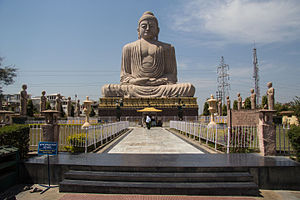Bodh Gaya
| Pilgrimage sites |
|---|
| Four main sites |
| Four additional sites |
| Other sites |
|
Bodh Gaya, according to Buddhist tradition, is the place where Gautama Buddha attained enlightenment under a sacred tree that became known as the Bodhi Tree.[1] Bodh Gaya is located in Gaya district in the Indian state of Bihar.
For Buddhists, Bodh Gaya is the most important of the four main pilgrimage sites related to the life of Gautama Buddha, the other three being Lumbini, Sarnath, and Kushinagar. In 2002, the Mahabodhi Temple, located in Bodh Gaya, became a UNESCO World Heritage Site.[2]
The disciples of Gautama Siddhartha began to visit the place during the full moon in the month of Vaisakh (April–May). Over time, the place became known as Bodh Gaya, the day of enlightenment as Buddha Purnima, and the tree as the Bodhi Tree.
The history of Bodh Gaya is documented by many inscriptions and pilgrimage accounts. Foremost among these are the accounts of the Chinese pilgrims Faxian in the 5th century and Xuanzang in the 7th century. The area was at the heart of a Buddhist civilization for centuries, until it was conquered by Turkic armies in the 13th century. The place-name, Bodh Gaya, did not come into use until the 18th century CE. Historically, it was known as Uruvela, Sambodhi, Vajrasana or Mahabodhi.[3] The main monastery of Bodh Gaya used to be called the Bodhimanda-vihāra (Pali). Now it is called the Mahabodhi Temple.
- Further reading
Notes
- ↑ Gopal, Madan (1991). K.S. Gautam, ed. India through the ages. Publication Division, Ministry of Information and Broadcasting, Government of India. p. 176.
- ↑ "Decisions adopted by the 26th Session of the World Heritage Committee" (PDF). World Heritage Committee. p. 62. Archived (PDF) from the original on 28 February 2015. Retrieved 10 July 2006.
- ↑ "A History of Bodh Gaya by Venerable S. Dhammika". Buddhanet.net. Retrieved 2014-06-02.
| This article includes content from Bodh Gaya on Wikipedia (view authors). License under CC BY-SA 3.0. |
